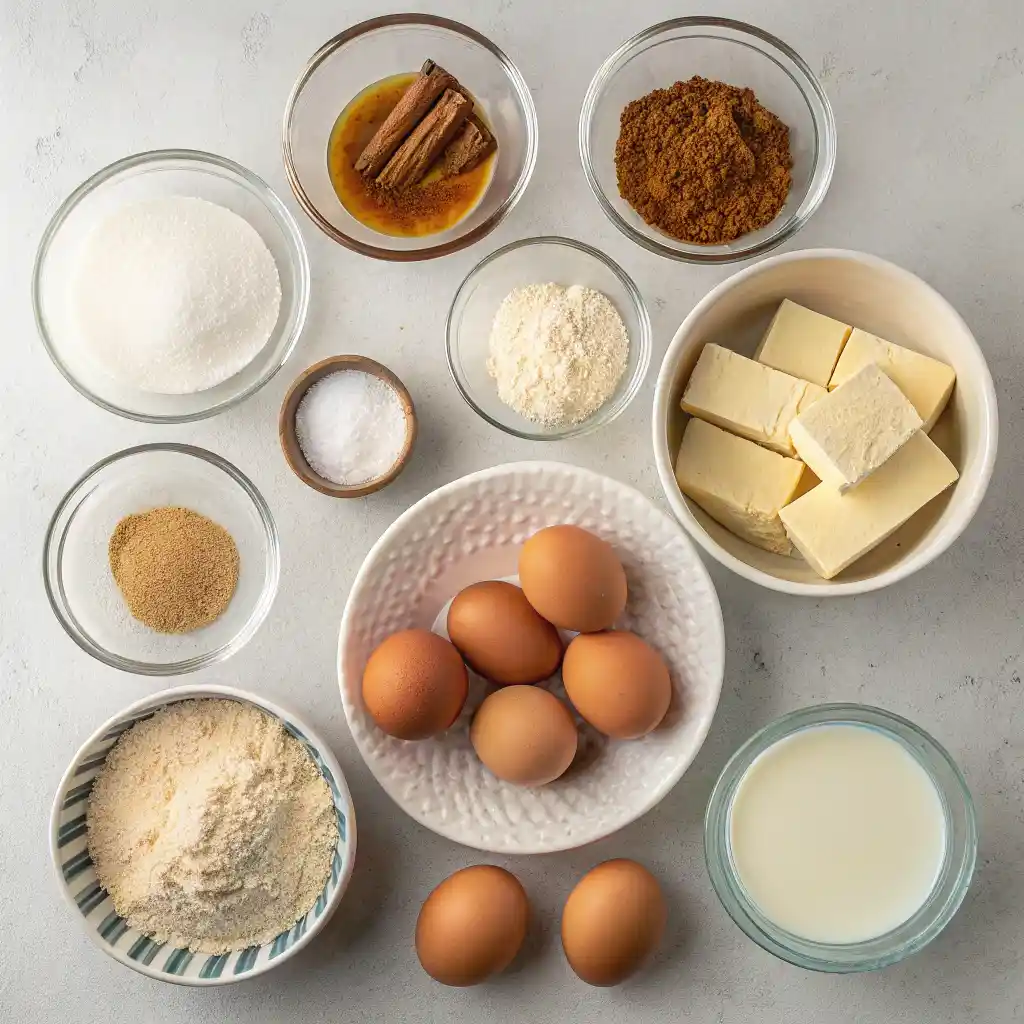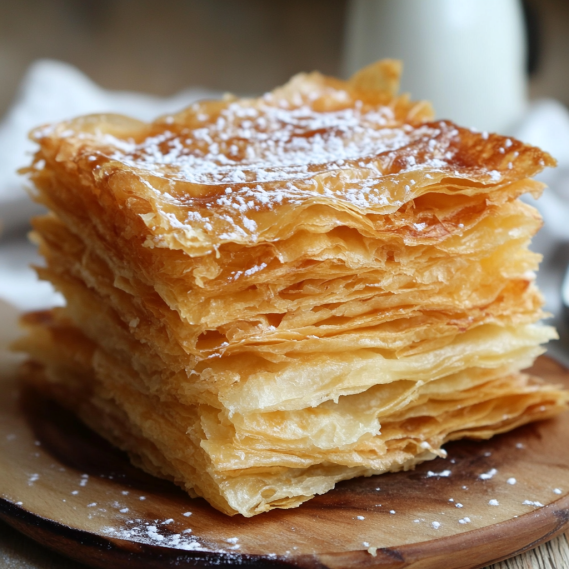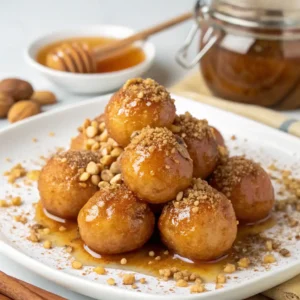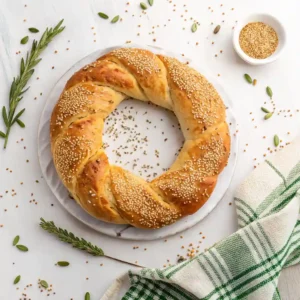There’s something magical about biting into a warm piece of bougatsa, with its delicate layers of crispy phyllo embracing a creamy custard center, all dusted with a sweet cloud of powdered sugar and aromatic cinnamon. This classic Greek dessert has been delighting taste buds for generations, yet it remains somewhat overshadowed by its more famous cousin, galaktoboureko, in many international circles.
Table of Contents
The Great Greek Dessert Debate: Bougatsa vs. Galaktoboureko
Greek food enthusiasts often engage in friendly debates about the merits of bougatsa versus galaktoboureko. While both desserts feature phyllo and custard, they offer distinctly different culinary experiences.
The differences start with syrup – galaktoboureko bathes in a generous helping of citrus-infused syrup, creating a sweet, moist texture throughout. Bougatsa, meanwhile, remains syrup-free, allowing the natural flavors of the custard to shine while maintaining the phyllo’s crispness. Instead, bougatsa receives its finishing touch from a light dusting of cinnamon and powdered sugar on top.
The custard itself differs significantly between these two desserts. Bougatsa features a thinner layer of custard that maintains a wonderfully creamy, almost oozy consistency when served warm. This creates a delightful contrast against the crisp phyllo exterior.
Presentation provides another point of distinction. While galaktoboureko typically appears as a large pan-baked dessert cut into pieces, bougatsa often takes the form of individual parcels or servings. This individual packaging creates a higher phyllo-to-custard ratio, especially around the edges, offering more of that satisfying crunch with each bite.
The Essential Ingredients Bougatsa

Creating authentic bougatsa requires several key ingredients:
Phyllo Dough: These paper-thin unleavened sheets form the foundation of bougatsa. While frozen phyllo works well, fresh phyllo dough offers superior texture and flavor if you can find it.
Unsalted Butter: Used liberally between phyllo layers and in the custard, butter provides richness and helps achieve that golden-brown color during baking.
Milk: Forms the base of the custard. Different types of milk can be used depending on your preference for richness.
Granulated Sugar: Provides just enough sweetness without overwhelming the delicate custard flavors.
Large Eggs: These bind the custard and contribute to its silky texture.
Durum Wheat Semolina: This coarse yellow flour is crucial for achieving the authentic texture of bougatsa’s custard. It creates a unique mouthfeel that distinguishes bougatsa from other custard desserts.
Vanilla Powder: Traditional bougatsa recipes often specify vanilla powder rather than extract, as it imparts flavor without altering the custard’s color or consistency.
Cinnamon and Icing Sugar: The final dusting that gives bougatsa its signature appearance and adds a perfect finishing touch to the flavor profile.
Creating Bougatsa : A Step-by-Step Guide
The process begins with preheating your oven to 350°F (175°C), setting the stage for the magic to happen.
Start by preparing the custard – the heart of this dessert. In a saucepan, combine melted butter, sugar, milk, semolina, and vanilla. The key here is constant stirring over medium heat to prevent the mixture from sticking or forming lumps. You’ll notice the mixture beginning to thicken as the semolina absorbs the liquid.
Next comes a crucial step: incorporating the eggs. Beat your eggs in a separate bowl, then slowly add them to the pot while stirring continuously. This gradual approach prevents the eggs from scrambling when they hit the hot mixture. Continue stirring until the custard reaches a pudding-like consistency, then set it aside to cool slightly.
Working with phyllo requires some preparation. Unwrap your phyllo sheets and cut them to the desired size. Remember to keep unused phyllo covered with a damp cloth to prevent it from drying out – this is perhaps the most important tip for phyllo success.
Now comes the assembly. Lay out a sheet of phyllo, brush it with melted butter, and layer another sheet on top. Repeat until you have 3-4 layers. Place a portion of custard in the center, then fold the edges over to create a neat parcel. Brush the top with more butter to ensure a golden finish during baking.
Transfer your bougatsa parcels to a parchment-lined baking sheet and bake for approximately 20 minutes, or until the phyllo turns a beautiful golden brown. Allow them to cool slightly before dusting with cinnamon and powdered sugar.
Demystifying Phyllo
Many home cooks feel intimidated by phyllo dough, but it’s more forgiving than its reputation suggests. The key is keeping unused sheets covered to prevent drying and working efficiently but not rushing.
Fresh phyllo is ideal but can be difficult to find outside Greece or specialized markets. Frozen phyllo makes an excellent substitute – just ensure it’s fully thawed in the refrigerator before use.
Variations and Serving Suggestions
While custard-filled bougatsa remains the most popular variety, regional variations exist throughout Greece. In Crete, for example, you’ll find cheese-filled bougatsa, offering a savory counterpoint to the sweet version.
For the full Greek experience, serve bougatsa alongside traditional Greek coffee. The contrast between the sweet dessert and robust coffee creates a perfect balance. Alternatively, mountain tea (tsai tou vounou) or a simple glass of milk complements bougatsa beautifully.
Beyond Bougatsa : Related Greek Phyllo Desserts
If you enjoy bougatsa, you might want to explore other Greek phyllo-based treats. Portokalopita uses crumbled phyllo to create an orange-infused cake with unique texture. And of course, there’s baklava, perhaps the most internationally recognized Greek dessert, featuring layers of phyllo, nuts, and sweet syrup.
Final Thoughts
Bougatsa represents Greek dessert-making at its finest – simple ingredients transformed through careful technique into something truly special. The contrast between crisp phyllo and creamy custard, finished with the subtle sweetness of powdered sugar and warmth of cinnamon, creates a multi-sensory experience that connects modern diners with centuries of Greek culinary tradition.
Whether enjoyed as a sweet breakfast treat, afternoon indulgence, or after-dinner dessert, bougatsa delivers a taste of Greek hospitality that turns any ordinary moment into a celebration. So heat your oven, gather your ingredients, and prepare to create a dessert that will transport your taste buds straight to a sun-drenched Greek café.
For more Greek recipes, visit this link : Guide to Greek Breakfast
Q1: What is Bougatsa?
A1: Bougatsa is a traditional Greek pastry made with crispy phyllo dough, often filled with either sweet custard or savory cheese. It’s popular for breakfast or as a snack throughout Greece.
Q2: Can I make Bougatsa with other fillings?
A2: Yes! While custard and cheese are the most common fillings, you can also try variations like chocolate, nuts, or even fruit preserves for a unique twist.
Q3: Is Bougatsa served hot or cold?
A3: Bougatsa is typically served warm, but it can also be enjoyed at room temperature, making it a great pastry for breakfast, lunch, or a sweet treat any time of day.




